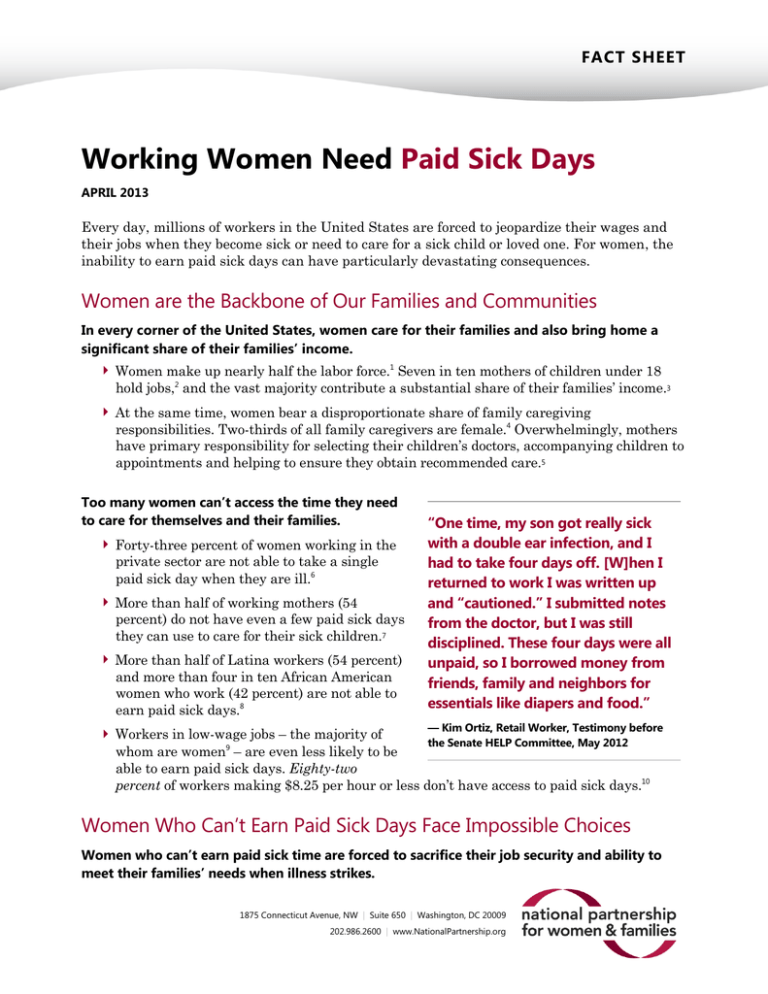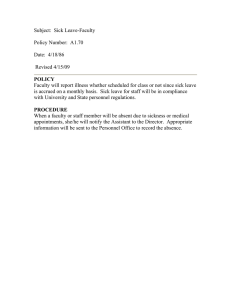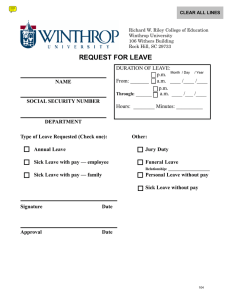
FACT SHEET
Working Women Need Paid Sick Days
APRIL 2013
Every day, millions of workers in the United States are forced to jeopardize their wages and
their jobs when they become sick or need to care for a sick child or loved one. For women, the
inability to earn paid sick days can have particularly devastating consequences.
Women are the Backbone of Our Families and Communities
In every corner of the United States, women care for their families and also bring home a
significant share of their families’ income.
Women make up nearly half the labor force.1 Seven in ten mothers of children under 18
hold jobs,2 and the vast majority contribute a substantial share of their families’ income.3
At the same time, women bear a disproportionate share of family caregiving
responsibilities. Two-thirds of all family caregivers are female.4 Overwhelmingly, mothers
have primary responsibility for selecting their children’s doctors, accompanying children to
appointments and helping to ensure they obtain recommended care.5
Too many women can’t access the time they need
to care for themselves and their families.
Forty-three percent of women working in the
private sector are not able to take a single
paid sick day when they are ill.6
More than half of working mothers (54
percent) do not have even a few paid sick days
they can use to care for their sick children.7
More than half of Latina workers (54 percent)
and more than four in ten African American
women who work (42 percent) are not able to
earn paid sick days.8
“One time, my son got really sick
with a double ear infection, and I
had to take four days off. [W]hen I
returned to work I was written up
and “cautioned.” I submitted notes
from the doctor, but I was still
disciplined. These four days were all
unpaid, so I borrowed money from
friends, family and neighbors for
essentials like diapers and food.”
— Kim Ortiz, Retail Worker, Testimony before
Workers in low-wage jobs – the majority of
the Senate HELP Committee, May 2012
whom are women9 – are even less likely to be
able to earn paid sick days. Eighty-two
percent of workers making $8.25 per hour or less don’t have access to paid sick days.10
Women Who Can’t Earn Paid Sick Days Face Impossible Choices
Women who can’t earn paid sick time are forced to sacrifice their job security and ability to
meet their families’ needs when illness strikes.
1875 Connecticut Avenue, NW | Suite 650 | Washington, DC 20009
202.986.2600 | www.NationalPartnership.org
Forty-two percent of women have had the experience of being unable to take time off of
work to care for a child; 27 percent were unable to take time off to care for a parent.11
One in five women with children (20 percent) report that they or a family member have
been fired or disciplined by an employer for taking time off to cope with an illness or to
care for a sick child or family member.12
For the typical family without paid sick days, just 3.5 sick days without pay is equivalent
to losing an entire month of groceries.13 For single-parent families, which are usually
headed by women, the consequences are even more dire.
America’s Working Families Deserve a Solution
Illness has no geographic boundaries. America’s workers and communities need a national
standard that allows all working people to earn paid sick days.
Currently, no federal law guarantees workers the right to earn paid sick days.
Connecticut is the only state with a law that gives some workers this basic right, along
with the cities of San Francisco, Washington, D.C., Seattle and Portland, Oregon.
The Healthy Families Act (H.R. 1286/S. 631in the 113th Congress) would enable workers in
businesses with 15 or more employees to earn up to seven paid sick days a year to recover
from short-term illness, care for a sick family member, seek routine medical care or deal
with the effects of domestic or sexual violence.
A national paid sick days standard would ensure that working women have the job
stability and economic security they need to take care of themselves and their family
members.
1 U.S. Bureau of Labor Statistics. (2012, August 3). Employment status of the civilian population by sex and age (Table A-1). Retrieved 27 August 2012, from
http://www.bls.gov/news.release/empsit.t01.htm (Unpublished calculation)
2 U.S. Bureau of Labor Statistics. (2012, April 26). Employment Characteristics of Families – 2011 [Press release] (p. 2). Retrieved 24 August 2012, from
http://www.bls.gov/news.release/archives/famee_04262012.pdf
3 Boushey, H., & O’Leary, A. (Eds.). (2009). The Shriver Report: A Woman’s Nation Changes Everything. Shriver Report Publication. Retrieved 22 August 2012, from
http://www.shriverreport.com/awn/shriverReport.pdf
4 National Alliance for Caregiving. (2009, November). Caregiving in the U.S. National Alliance for Caregiving and AARP publication. Retrieved 27 August 2012, from
http://www.caregiving.org/data/Caregiving_in_the_US_2009_full_report.pdf
5 Kaiser Family Foundation. (2011, May). Women’s Health Care Chartbook: Key Findings from the Kaiser Women’s Health Survey. Retrieved 21 August 2012, from
http://www.kff.org/womenshealth/upload/8164.pdf
6 Institute for Women’s Policy Research. (2011, March). Paid Sick Day Access Rates by Gender and Race/Ethnicity. Retrieved 24 August 2012, from
http://www.iwpr.org/publications/pubs/paid-sick-day-access-rates-by-gender-and-race-ethnicity-2010
7 Smith, K., & Schaefer, A. (2012, June). Who Cares for the Sick Kids? Parents’ Access to Paid Time to Care for a Sick Child. Carsey Institute at the University of New Hampshire
publication. Retrieved 29 August 2012, from http://www.carseyinstitute.unh.edu/sites/carseyinstitute.unh.edu/files/publications/IB-Smith-Paid-Sick-Leave-2012.pdf
8 See note 6.
9 U.S. Government Accountability Office. (2011, October). Progress Made, but Women Remain Overrepresented among Low-Wage Workers. Retrieved 27 August 2012, from
http://www.gao.gov/products/GAO-12-10
10 U.S. Bureau of Labor Statistics. (2012, July 11). Employee Benefits in the United States – March 2012 [Press release] (p. 16). Retrieved 27 August 2012, from
http://www.bls.gov/ncs/ebs/sp/ebnr0018.pdf
11 See note 3, p. 88.
12 Lake Research Partners. (2007, June). Banners from a Nationwide Survey of 1,200 likely voters, June 20th-27th, 2007 (p. 71). Unpublished survey results.
13 Gould, E., Filion, K., & Green, A. (2011, June). The need for paid sick days: The lack of a federal policy further erodes family economic security. Economic Policy Institute publication.
Retrieved 21 August 2012 from http://www.epi.org/publication/the_need_for_paid_sick_days/
The National Partnership for Women & Families is a nonprofit, nonpartisan advocacy group dedicated to promoting fairness in the workplace, access to quality health care and
policies that help women and men meet the dual demands of work and family. More information is available at www.NationalPartnership.org.
© 2013 National Partnership for Women & Families. All rights reserved.
NATIONAL PARTNERSHIP FOR WOMEN & FAMILIES | FACT SHEET | WORKING WOMEN NEED PAID SICK DAYS
2



